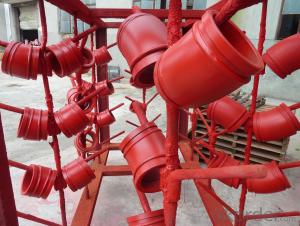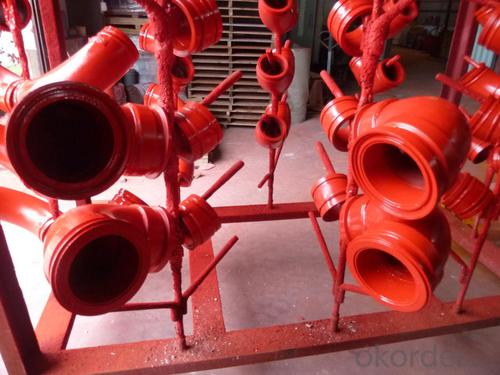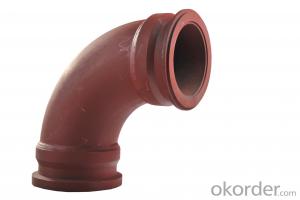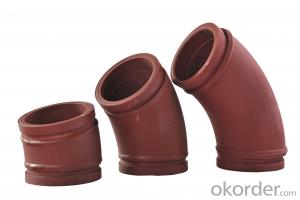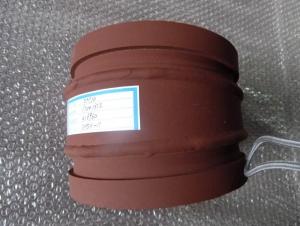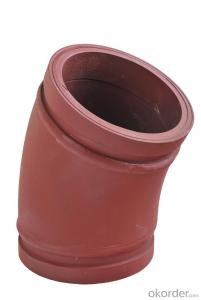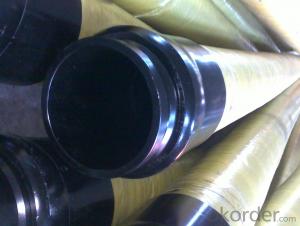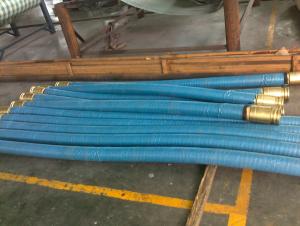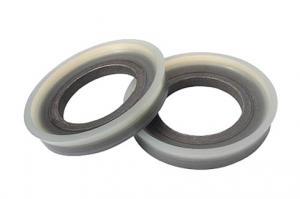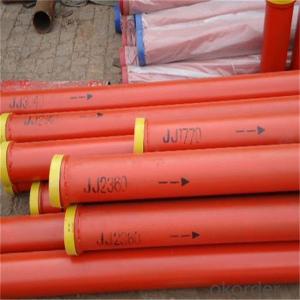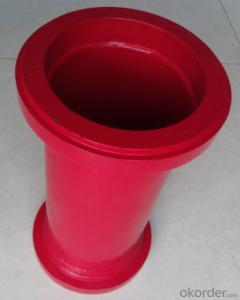Twin Wall Elbow for Concrete Pump R180 90DGR
- Loading Port:
- Tianjin
- Payment Terms:
- TT or LC
- Min Order Qty:
- 50 pc
- Supply Capability:
- 3000 pc/month
OKorder Service Pledge
OKorder Financial Service
You Might Also Like
Product Description:
Product Name: Twin Wall Pipe for Concrete Pump Pipe
Specification
(1) Material: Q235 (outside) + GCr15(inside)
(2) Thickness: 3mm (outside) + 9mm (inside)
(3) Technology: Quenching under high temperature
(4) Characteristics: the inner rigidity to 63 HRC; the outside has so high toughness to keep the inner.
(5) Matched with: Twin wall flange, Alloy (GCr15) + 20#
(6) Working Pressure:170bar
(7) Service life: above 60,000 cubic meters.
(8) Package: PP woven bag and plastic cap
3. Application
Concrete delivery.
4. Package
Put into containers.
FAQ:
Q1: Why buy Materials & Equipment from OKorder.com?
A1: All products have its ISO certifications, adheres to the highest standards and a commitment to supply chain safety and customer satisfaction.
Q2: How do we guarantee the quality of our products?
A2: We have established an advanced quality management system which conducts strict quality tests at every step, from raw materials to the final product. At the same time, we provide extensive follow-up service assurances as required.
Q3: How soon can we receive the product after purchase?
A3: Within three days of placing an order, we will begin production. The specific shipping date is dependent upon international and government factors, but is typically 10 to 30 workdays.
Q4: If we can produce Twin Wall Pipe for Concrete Pump Pipe Thickness 4.5mm Length 3000mm according to customers request?
A4: Yes, we can produce T Twin Wall Pipe for Concrete Pump Pipe Thickness 4.5mm Length 3000mm according to the difference country situations to make it suitable to the market and customers. We have very professional technical team to make the design.
Q5: How to make a quick resolution for after service?
A5: We have overseas branches all-around of world, If needed, the seller shall dispatch 2 engineers to the buyer's site for supervision of training. The buyer shall make available of necessary facilities &skilled personnel at site for training.
Images:
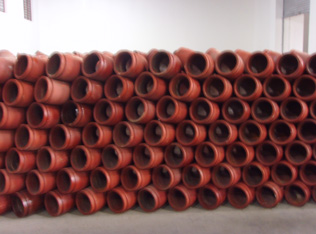

- Q: Are there any specific training or certifications required for handling and installing concrete pump spare parts?
- Yes, there are specific training and certifications required for handling and installing concrete pump spare parts. Due to the specialized nature of the equipment and the potential risks involved, individuals who handle and install concrete pump spare parts should undergo proper training and obtain relevant certifications. Firstly, it is essential to have a thorough understanding of the functioning and components of concrete pumps. This knowledge can be acquired through comprehensive training programs offered by equipment manufacturers, industry associations, and vocational schools. These training programs cover topics such as pump operation, maintenance, troubleshooting, and safety protocols. Additionally, specific certifications may be required depending on the jurisdiction or industry standards. For example, the American Concrete Pumping Association (ACPA) offers a certification program known as the ACPA Operator Certification. This certification requires individuals to demonstrate their knowledge and skills related to concrete pumping equipment, including the handling and installation of spare parts. Obtaining these certifications ensures that individuals are equipped with the necessary knowledge and skills to handle and install concrete pump spare parts safely and efficiently. It also helps in maintaining compliance with industry regulations and standards. It is important to note that the specific training and certification requirements may vary depending on the region, industry, and the type of concrete pump being used. Therefore, it is recommended to consult local regulations and industry guidelines to ensure compliance with the necessary training and certification requirements for handling and installing concrete pump spare parts.
- Q: What are the different types of concrete pump wear rings?
- There are primarily two types of concrete pump wear rings: stationary wear rings and rotating wear rings. Stationary wear rings are fixed in position and provide a surface for the rotating wear ring to slide against. Rotating wear rings, on the other hand, are designed to spin with the impeller and prevent direct contact between the impeller and stationary wear ring, reducing friction and extending the life of the pump.
- Q: What is the function of a concrete pump hopper agitator shaft bearing?
- The primary function of the bearing on the agitator shaft of a concrete pump hopper is to offer support and facilitate smooth rotation. Typically constructed from strong materials like steel or bronze, the bearing is designed to endure substantial loads and vibrations. Its purpose is to minimize friction and prevent premature seizing or wear of the agitator shaft. Furthermore, the bearing aids in maintaining the alignment of the shaft, thereby ensuring efficient concrete mixing within the hopper. Overall, the bearing on the agitator shaft of a concrete pump hopper is essential for its reliable and consistent performance.
- Q: What are the consequences of using substandard concrete pump spare parts?
- There are several consequences to using substandard concrete pump spare parts. Firstly, these parts may not fit properly or be of the same quality as the original ones, which can lead to a decrease in the overall performance and efficiency of the pump. This can result in the pump being unable to deliver the necessary amount of concrete or experiencing frequent breakdowns, causing project delays and higher costs. Secondly, substandard parts may have a shorter lifespan compared to genuine parts. This means that they may wear out or break down sooner, requiring more frequent replacements. This not only increases maintenance costs but also raises the risk of unexpected equipment failures during operation, which can be hazardous for workers and potentially cause accidents. Moreover, the use of substandard parts can compromise the safety of the concrete pump. Genuine parts are designed and manufactured to meet strict quality standards and ensure proper equipment functioning. In contrast, substandard parts may not undergo the same rigorous testing and quality control measures, making them less reliable and more prone to failure. This poses a serious risk to operators and other personnel working near the concrete pump. Additionally, the use of substandard parts can void any warranties or guarantees provided by the manufacturer. Manufacturers typically offer warranties on their products to ensure customer satisfaction and provide support in case of any issues. However, if substandard parts are used, the manufacturer may refuse to honor the warranty, leaving the owner responsible for any necessary repairs or replacements. To summarize, the use of substandard concrete pump spare parts can lead to reduced performance, increased maintenance costs, greater accident risks, and voided warranties. It is crucial to always use genuine parts specifically designed for the concrete pump to ensure optimal performance, longevity, and safety.
- Q: How can you determine when a concrete pump pipe needs to be replaced?
- Determining whether a concrete pump pipe requires replacement involves several factors to consider. 1. Visual Examination: Thoroughly inspect the pipe visually, searching for cracks, damages, or indications of wear and tear. Pay close attention to the pipe's ends where it connects to the pump and nozzle, as these regions are more susceptible to damage. 2. Performance Assessment: Observe the concrete pump's performance. If there is a decline in pumping efficiency, such as reduced output or difficulties in maintaining pressure, it may indicate a pipe problem. Furthermore, excessive leakage or blockages in the pipe could signify the need for replacement. 3. Age and Usage: Take into account the pipe's age and the extent of its usage. Concrete pump pipes have a limited lifespan, and over time and extensive use, they can deteriorate and lose their structural integrity. If the pipe is old and has undergone substantial use, it might be time for a replacement. 4. Regular Maintenance and Repairs: Frequent repairs or maintenance on the pipe could suggest that it is approaching the end of its lifespan. While regular maintenance can extend the pipe's life, if repairs are becoming more frequent and costly, it may be more cost-effective to replace it. 5. Safety Considerations: Prioritize safety when deciding on pipe replacement. If there are significant structural issues or concerns about the pipe's ability to handle pressure, it is crucial to replace it to prevent potential accidents or hazardous situations. Ultimately, the decision to replace a concrete pump pipe should be based on a combination of visual inspection, performance evaluation, age, usage, regular maintenance, and safety considerations. It is advisable to seek guidance from a professional or experienced technician who can assess the pipe's condition and offer expert advice on whether replacement is necessary.
- Q: How do I maintain and clean concrete pump spare parts?
- Maintaining and cleaning concrete pump spare parts involves regular inspections, lubrication, and following proper cleaning procedures. Firstly, conduct routine checks to identify any signs of wear, damage, or loose connections. Lubricate the moving parts as recommended by the manufacturer to ensure smooth operation and prevent rust. When cleaning, use a mild detergent and water solution to remove any dirt, debris, or concrete residue. Avoid using harsh chemicals or abrasive tools that could damage the parts. It's crucial to follow the manufacturer's guidelines and consult the equipment manual for specific instructions on maintaining and cleaning concrete pump spare parts.
- Q: How often should concrete pump lubrication systems be inspected and maintained?
- Concrete pump lubrication systems should be inspected and maintained regularly, ideally on a monthly basis.
- Q: What is the first generation pumping technology of concrete pump?
- The failure rate and maintenance cost are very high, and it is easy to delay the progress of the project
- Q: What are the precautions for gas washing of concrete pump?
- Compressed air pressure shall not be higher than 0.7MPa
- Q: How often should concrete pump cylinders be inspected and replaced?
- Concrete pump cylinders should be inspected regularly, ideally on a daily basis, to ensure they are in proper working condition. The frequency of replacement depends on several factors including the intensity of usage, maintenance practices, and the quality of the concrete being pumped. Generally, concrete pump cylinders should be replaced when they show signs of significant wear and tear or when they no longer meet the required performance standards.
Send your message to us
Twin Wall Elbow for Concrete Pump R180 90DGR
- Loading Port:
- Tianjin
- Payment Terms:
- TT or LC
- Min Order Qty:
- 50 pc
- Supply Capability:
- 3000 pc/month
OKorder Service Pledge
OKorder Financial Service
Similar products
Hot products
Hot Searches
Related keywords




